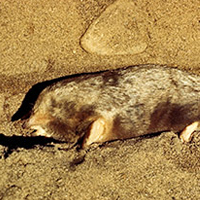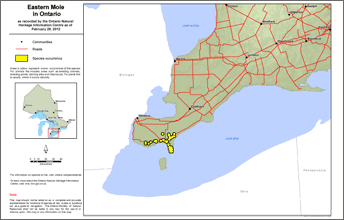Eastern mole
Scientific name: Scalopus aquaticus

Cover photo credit: Tim Gibb
Status
Special Concern
“Special Concern” means the species lives in the wild in Ontario, is not endangered or threatened, but may become threatened or endangered due to a combination of biological characteristics and identified threats.
Date added to the Species at Risk in Ontario List
The Eastern Mole was already assessed as a species of special concern when the Endangered Species Act took effect in 2008.
What it looks like
The Eastern Mole is a small mammal, about 16 centimetres long from nose to tail. It has velvety grey fur, large scoop-shaped front paws for digging, a slim pointed nose, tiny eyes and a short hairless tail. The mole eats worms, insect larvae, ants, plant tubers and seeds that it finds in the tunnels it digs.
The Eastern Mole is secretive and rarely seen, but leaves clear signs of its activity - raised earth tunnels and mounds of excavated dirt ("push ups" or molehills) that it builds in lawns, gardens and fields.
Eastern Moles live about three years. They breed and reproduce once a year with litters of two to five young.
Where it lives
The Eastern Mole lives in a range of habitats, including forests, open woodlands, meadows, pastures and fields. It is also found in urban settings such as parks, cemeteries and residential yards. Its preferred habitat is stone-free sand and sandy loam soil with a cover of woody plants.
Where it’s been found in Ontario
Widespread and common in eastern and central North America, the range of the Eastern Mole is restricted to the extreme southwestern part of Ontario. It was never common in the province.
View a larger version of this map (PDF)
What threatens it
Much of the suitable habitat for Eastern Moles has been converted to farmland. Fragmented, small populations can disappear at any time and are very slow to return.
Action we are taking
Special concern species do not receive species or habitat protection.
What you can do
Report a sighting
- Report a sighting of an endangered animal or plant to the Natural Heritage Information Centre. Photographs with specific locations or mapping coordinates are always helpful.
- The Carolinian forests of southern Ontario support an amazing diversity of plants and wildlife, including many species at risk. Carolinian Canada is working to help recover species at risk and their habitats. For more information, visit: www.carolinian.org/SpeciesHabitats.htm.
Volunteer
- Volunteer with your local nature club or provincial park to participate in surveys or stewardship work focused on species at risk.
Be a good steward
- Private land owners have a very important role to play in species recovery. You may be eligible for stewardship programs that support the protection and recovery of species at risk and their habitats.
Report illegal activity
- Report any illegal activity related to plants and wildlife to
1-877-TIP-SMNR (847-7667) .
Quick facts
- Eastern Moles can dig more than a metre in an hour, and their tunnels can be up to a kilometre long.
- Young Eastern Moles are cared for and nursed by their mother in her nest and tunnel system until they are weaned. They continue to share her tunnel system until they are able to forage on their own, when they leave and establish their own tunnel systems.
- Although these moles have no vision, they may be able to detect the presence or absence of light. Their ears are also covered by a layer of skin but they may be able to detect sounds and vibrations. Eastern Moles probably find their way around and detect prey by their acute senses of smell and touch.
- Eastern Moles spend 99 per cent of their time in their underground tunnels, where there are few predators that can find and catch them.
